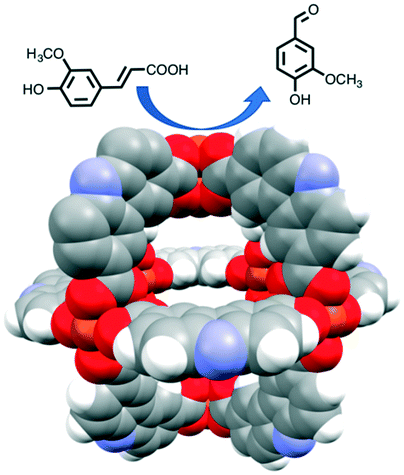A new method of producing vanillin (3-methoxy-4-hydroxybenzaldehyde) from ferulic acid using a catalytic MOP has been reported.
Vanillin, one of the main chemical components of vanilla, is an important flavouring agent in the food, cosmetic and other industries. However, although it can be extracted from vanilla pods, less than 1% of the required quantity is obtained in this way. The remainder is obtained by chemical synthesis using strong oxidising agents and toxic solvents. Biotechnological production is also possible but there are problems with time-scale, purification and the nature of the bacteria used. There is, therefore, a demand for cleaner, greener methods of production of vanillin.
This paper reports the production of vanillin in 60% yield from ferulic acid and hydrogen peroxide, when a MOP (metal-organic polyhedron) is used as a catalyst. Like MOFs (metal-organic frameworks), MOPs are constructed from metal ions and organic ligands but rather than forming frameworks, MOPs are discrete polyhedra. MOFs have been widely studied as potential catalysts but MOPs are practically untried. Reasons for this include their relative lack of stability and tendency to aggregate. This paper uses the MOP formed from copper(II) and a ligand from 9H-carbazole-3,6-dicarboxylic acid. There are also coordinated dimethylformamide and water molecules in the structure.

The catalyst is activated by removing the coordinated solvent molecules by heating. Ferulic acid and hydrogen peroxide are then reacted in the presence of the MOP. Best results are obtained when the reaction mixture is sonicated (to reduce possible aggregation of MOP molecules). A mechanism is proposed starting with coordination of peroxide to the active Cu(II) coordination site (schematically shown above).
The recovered catalyst exhibits a loss of crystallinity and after 5 cycles activity shows a decline. However, the paper demonstrates the potential for the catalytic use of MOPs for the simple production of vanillin and other compounds.
For more details, read the full paper here:
Synthesis of vanillin via a catalytically active Cu(II)-metal organic polyhedron
DOI: 10.1039/C6CE02621D, Communication
 Gwenda Kyd has a PhD in metallocarborane chemistry from the University of Edinburgh. Other research work includes the spectroscopic study of the structure of glasses and organometallic electron-transfer reactions and the preparation of new inorganic phosphors. She published a book, ‘Molecules, Medicines and Mischief’, in 2014, on some of the chemicals found in plants and is currently working on a follow-up.
Gwenda Kyd has a PhD in metallocarborane chemistry from the University of Edinburgh. Other research work includes the spectroscopic study of the structure of glasses and organometallic electron-transfer reactions and the preparation of new inorganic phosphors. She published a book, ‘Molecules, Medicines and Mischief’, in 2014, on some of the chemicals found in plants and is currently working on a follow-up.










